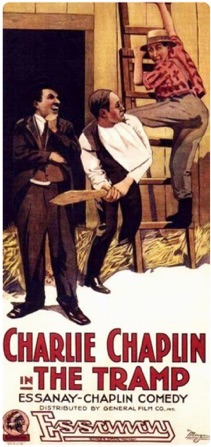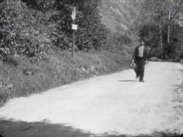The Tramp Poster
NEUER JOB 4/11
The Tramp – Charlie rettet Edna aus den Händen
einiger Räuber, verliebt sich auf der Farm, wo er einen
Job bekommen hat, in sie, und zieht weiter,
als er entdeckt. dass sie bereits einen Geliebten hat –
Charlie, der Held, der Räuber vertreibt. Clippings
Fritz Hirzel, Chaplins Schatten.
Bericht einer Spurensicherung. Zürich 1982
Dazu, wie es zu dieser Legende, zur Figur aus The Tramp
gekommen war, erschien 1915, kein halbes Jahr nach
der Uraufführung, in The Theatre ein erster, unter Chaplins Namen
veröffentlichter Artikel, in welchem die staunende Mitwelt
erfuhr, Chaplin sei in den Strassen San Franciscos zufällig einem
Landstreicher begegnet, habe ihn in eine Bar eingeladen
und sich, während er für Drinks und Essen aufgekommen sei, aus
dem Leben dieses Landstreichers, von seinen Tramptouren
und Fahrten auf Güterwagen, berichten lassen.
Für jeden, der sich vorzustellen versucht, wie der schüchterne,
elegant gekleidete Chaplin einen womöglich stinkenden
Landstreicher auf der Strasse aufliest und mit ihm
den Abend verbringt, eine gänzlich unglaubwürdige Geschichte,
ein Muster branchengerechter Publicity, weiter nichts.
Dabei mochte es durchaus sein, dass dieser Tramp,
der wenig gemeinsam hatte mit jenen Clochardtypen, die Chaplin
in seiner Kindheit in South London gesehen hatte, nach
dem wirklichen Leben entstanden war. Leute, die abgerissen im
Land herumzogen, gab es in Amerika viele.
Sogar im Kino auf der Leinwand gab es sie bereits.
zum Beispiel in The Lady and the Mouse, einem Griffithfilm
von 1913, in welchem die Figur des Tramps festgehalten
war, die Gestalt des Landstreichers, der krank und abgerissen
stranden muss, der aufgenommen wird von Krämersleuten,
denen er später die Gläubiger aus dem Laden zu schaffen weiss.
Und vielleicht, um noch einen Schritt weiterzugehen, war
es tatsächlich so, dass The Tramp, dieser erste Film, in welchem
Chaplin seine Figur mit einem Hauch von Mitgefühl, ja
Traurigkeit umgab, nirgendwo sonst so zwingend hätte entstehen
können als gerade dort draussen, in dieser ländlichen
Umgebung von Niles, in der Abgeschiedenheit der Filmkolonisten,
aus der Chaplin selbst inzwischen mit der ihm eigenen
Sehn- und Fernsucht sich wegzustehlen suchte.
Charles J. McGuirk, Chaplinitis,
Motion Picture, New York, August 1915
Meanwhile, out in the Essanay Western studio, in Niles,
Cal., there was produces a comedy called The Tramp.
It was written and produced by Chaplin, as a vehicle for his
own work. The story was old as the hills; the situations
would have been pronounced crude if they had been worked
by any other than Charlie Chaplin. But there was
something new in the picture. The tramp, after many adventures
characteristic of a city man‘s ignorance of farm life,
fell in love with the farmer‘s daughter, who was nursing
him thru an illness resulting from a wound he got in
defending her home from an attack of thieves.
Down in the projection-room of the Essanay studio,
the men who passed on the picture felt a chill across their backs
as the tramp discarded his humor and became pathetic.
The chill was of fear. Chaplin was stepping out of his province.
The girl‘s real sweetheart appeared on the scene and
was taken into her arms. The tramp saw his air-castles crumbling
into dust. He wrote a note – the crude note of an uneducated
man. He left it on the table, tied up his red bandanna
handkerchief and put it on his cane. He shyly took his leave
of the girl o‘ dreams and started on his journey to world‘s
end. The men in the projecting-room felt the the chill give way
to a lump in the throat. The tramp had built too high and
his foolish dream was being shattered. A rather funny situation,
you think? Well, there were tears in the men‘s eyes.
Chaplin had crossed the border into pathos, and had expressed
it solidly and surely. While he was walking down the road,
there was dejection in every movement. But the light-heartedness
of the nomad again gained the ascendancy. Chaplin shook
himself, gave a characteristic flirt of his coat, and wandered jauntily
out of the picture. And the audience smiled, with tears
in its eyes.
What will he do next? Surely not, like Eddie Foy,
will he yearn for the unattainable and attempt to do Hamlet.
His is a genius that bends everything in his touch,
however, and, like David Warfield, who came into public favor
as second fiddle to Weber and Fields, his versatility
may carry him into the field of straight comedy, or comedy-drama,
in such grand characterizations as Warfield‘s Music
Master, which was one of the milestones of theatrical success.
Give Chaplin a great photoplay, a strong, virile, lovable
part, and the brainy little man with the far-away look in his eyes
will astonish and hold us yet with his breadth of a genius
that has just begun to try its first fight of fancy. Out in Niles, Charlie
was informed that another story was being written about
him. Then some showed him his likeness on the cover of a famous
magazine devoted to Moving Pictures, and a third informed
him that a chorus of show-girls, each one costumed à la Chaplin,
was the latest hit on Broadway. Charlie shrugged his
shoulders and looked into space.
„Say,“ he said. „Did you see The Tramp?“
Charles Chaplin, How I Made My Success,
Developement of the Comic Story and the Tramp Character,
The Theatre, 22. September 1915
Ich versuche stets das Burleske zu meiden oder wenigstens
nicht drauf angewiesen zu sein. Ich bemühe mich in allem, was ich
mache, um Natürlichkeit. Ein Beispiel dafür, wie ich ein Stück
ausarbeite und weiterentwickle, findet man in The Tramp.
Die Inspiration kam von einer zufälligen Begegnung mit einem Landstreicher in einer Strasse von San Francisco. Er hatte
die üblichen Symptome seiner Klasse.
Harry C. Carr, Charlie Chaplin´s Story,
Photoplay, October 1915
He made the greatest advance in this direction
in The Tramp. In this, there was not only a real story, but a touch
of real pathos which gave Chaplin a chance for the
greatest ,finish‘ that has ever been shown in any movie
comedy. I think every one who saw it will agree
with me on that point.“
„Chaplin‘s idea is that one of the old style rough comedies
gives absolutely no chance for real effects. When the
paperhanger has spilled paste down the back of the dude
and somebody has been pushed off into the lake,
the comedy has been exhausted. Plays like The Tramp open
up all kinds of chances for contrasts, – lights and shade.
He does many things now because he believes ,the public
wants them so‘ – and for no other reason.“
Maurice Florey/Robert Bessy,
Monsieur Chaplin ou Le Rire dans la Nuit, Paris 1952
Totheroh erzählte mir, dass Chaplin, der von Tag zu Tag
berühmter wurde, sich in diesem verlorenen Loch von
Niles zutode gelangweilt habe und dass er, seit dem Monat Mai,
seine Ungeduld nicht verhehlte nach Los Angeles
zurückzukehren, wo er seine Abende gern im Sunset Inn,
im Hotel Alexandria, im Ship Café oder in der Boxarena
von Vernon verbrachte.
The Tramp Clippings
Chaplins Schatten Neuer Job weiter zurück



